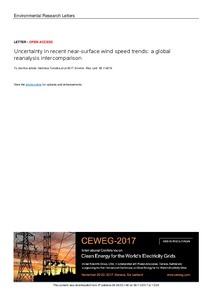Uncertainty in recent near-surface wind speed trends: a global reanalysis intercomparison

Cita com:
hdl:2117/110156
Tipus de documentArticle
Data publicació2017-11-06
EditorIOP Publishing
Condicions d'accésAccés obert
Llevat que s'hi indiqui el contrari, els
continguts d'aquesta obra estan subjectes a la llicència de Creative Commons
:
Reconeixement-NoComercial-SenseObraDerivada 3.0 Espanya
ProjecteREFUERZO DE LA RED ENERGETICA EUROPEA CON EL USO DE SERVICIOS CLIMATICOS (MINECO-CGL2013-41055-R)
EUPORIAS - EUropean Provision Of Regional Impact Assessment on a Seasonal-to-decadal timescale (EC-FP7-308291)
SPECS - Seasonal-to-decadal climate Prediction for the improvement of European Climate Services (EC-FP7-308378)
EUPORIAS - EUropean Provision Of Regional Impact Assessment on a Seasonal-to-decadal timescale (EC-FP7-308291)
SPECS - Seasonal-to-decadal climate Prediction for the improvement of European Climate Services (EC-FP7-308378)
Abstract
Reanalysis products have become a tool for wind energy users requiring information about the wind speed long-term variability. These users are sensitive to many aspects of the observational references they employ to estimate the wind resource, such as the mean wind, its seasonality and long-term trends. However, the assessment of the ability of atmospheric reanalyses to reproduce wind speed trends has not been undertaken yet. The wind speed trends have been estimated using the ERA-Interim reanalysis (ERA-I), the second version of the Modern Era Retrospective-Analysis for Research and Applications (MERRA-2) and the Japanese 55-year Reanalysis (JRA-55) for the period 1980–2015. These trends show a strong spatial and seasonal variability with an overall increase of the wind speed over the ocean and a tendency to a decline over land, although important disagreements between the different reanalyses have been found. In particular, the JRA-55 reanalysis produces more intense trends over land than ERA-I and MERRA-2. This can be linked to the negative bias affecting the JRA-55 near-surface wind speeds over land. In all the reanalyses high wind speeds tend to change faster than both low and average wind speeds. The agreement of the wind speed trends at 850 hPa with those found close to the surface suggests that the main driver of the wind speed trends are the changes in large-scale circulation.
CitacióTorralba, V.; Doblas-Reyes, F. J.; Gonzalez-Reviriego, N. Uncertainty in recent near-surface wind speed trends: a global reanalysis intercomparison. "Environmental Research Letters", 6 Novembre 2017, vol. 12, núm. 11.
ISSN1748-9326
Col·leccions
| Fitxers | Descripció | Mida | Format | Visualitza |
|---|---|---|---|---|
| Uncertainty in ... face wind speed trends.pdf | 2,079Mb | Visualitza/Obre |


